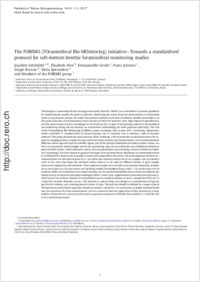The FOBIMO (FOraminiferal BIo-MOnitoring) initiative—Towards a standardised protocol for soft-bottom benthic foraminiferal monitoring studies
- Schönfeld, Joachim Helmholtz Centre for Ocean Research Kiel (GEOMAR), Kiel, Germany
- Alve, Elisabeth Department of Geosciences, University of Oslo, Norway
- Geslin, Emmanuelle Laboratory of Recent and Fossil Bio-Indicators, CNRS-UMR Université d'Angers,France
- Jorissen, Frans Laboratory of Recent and Fossil Bio-Indicators, CNRS-UMR Université d'Angers,France
- Korsun, Sergei Department of Invertebrate Zoology, Faculty of Biology and Soil Science, St. Petersburg State University, Russia
- Spezzaferri, Silvia University of Fribourg, Department of Geosciences, Switzerland
-
12.06.2012
Published in:
- Marine Micropaleontology. - 2012, vol. 94-95, p. 1-13
English
The European Community Marine Strategy Framework Directive (MSFD) was established to provide guidelines for monitoring the quality of marine ecosystems. Monitoring the status of marine environments is traditionally based on macrofauna surveys, for which standardised methods have been established. Benthic foraminifera are also good indicators of environmental status because of their fast turnover rates, high degree of specialisation, and the preservation of dead assemblages in the fossil record. In spite of the growing interest in foraminiferal bio-monitoring during the last decades, no standardised methodology has been proposed until today. The aim of the FOraminiferal BIo-MOnitoring (FOBIMO) expert workshop, held in June 2011 at Fribourg, Switzerland, which assembled 37 scientists from 24 research groups and 13 countries, was to develop a suite of standard methods. This paper presents the main outcome of the workshop, a list of motivated recommendations with respect to sampling devices, sample storage, treatment, faunal analysis and documentation. Our recommendations fulfil the criteria imposed both by scientific rigour and by the practical limitations of routine studies. Hence, our aim is to standardise methodologies used in bio-monitoring only and not to limit the use of different methods in pure scientific studies. Unless otherwise stated, all recommendations concern living (stained) benthic foraminiferal assemblages. We have chosen to propose two types of recommendations. Mandatory recommendations have to be followed if a study wants to qualify as sound and compatible to the norms. The most important of these recommendations are the interval from 0 to 1 cm below the sediment surface has to be sampled, and an interface corer or box corer that keeps the sediment surface intact is to be used for offshore surveys. A grab sampler must not be deployed in soft sediments. Three replicate samples are to be taken and analysed separately. Samples are to be washed on a 63-μm screen, and the living benthic foraminiferal fauna of the > 125 μm fraction is to be analysed. Splits are to be picked and counted entirely, and all counted foraminifera from at least one replicate per station have to be stored in micropalaeontological slides. Census data, supplementary laboratory data and microslides have to be archived. Advisory recommendations are to sample in autumn, to have a sample size of 50 cm2 or a tube of 8 cm inner diameter, to use > 70% ethanol as a preservative, rose Bengal at a concentration of 2 grams per litre for staining, and a staining time of at least 14 days. The split size should be defined by a target value of 300 specimens, heavy liquid separation should be avoided, and the 63–125 μm fraction or deeper sediment levels may be considered in some environments. We are convinced that the application of this protocol by a large number of scientists is a necessary first step to a general acceptance of benthic foraminifera as a reliable tool in bio-monitoring studies.
- Faculty
- Faculté des sciences et de médecine
- Department
- Département de Géosciences
- Language
-
- English
- Classification
- Hydrology
- License
- License undefined
- Identifiers
-
- RERO DOC 29510
- DOI 10.1016/j.marmicro.2012.06.001
- Persistent URL
- https://folia.unifr.ch/unifr/documents/302505
Statistics
Document views: 74
File downloads:
- spe_fit.pdf: 539
